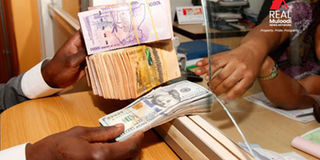What depreciating shilling means for Uganda's economy

The pick-up in corporate demand and some offshore demand for US Dollar led to the weakening of the shilling this week.
The economic performance outlook for the country released by the Finance ministry has shown that the Uganda Shilling last month depreciated by 0.64 percent, trading at an average mid-rate of Shs3,805.03/US$ from Shs3,780.66/US$.
The ministry says this was due to high demand for the dollar from manufacturing, oil, telecom and energy firms. It also adds that there was a reduction in the lending rates for both Shilling and foreign currency-denominated credit from 16.79 percent and 8.96 percent last November to 16.70 percent and 8.79 percent respectively last December. This was partly due to the relatively low and stable inflation.
Yields (interest rates) on Treasury Bills remained unchanged for the 91 and 182-day tenors at 9.8 percent and 12.4 percent respectively in January 2024. The annualised yield for the 364-day tenor edged upwards to 13.1 percent from 12.8 percent recorded the previous month.
The data set release also shows that the total stock of outstanding Private Sector Credit increased by 1.3 percent to Shs21.7 trillion last December from Shs21.4 trillion the previous month. This was partly due to the lower lending rates and continued improvement in economic activity during the month.
During December 2023, Uganda’s trade deficit with the rest of the world narrowed by 9.9 percent to $269.87m from $299.65m last November. This was on account of both a reduction in the import bill and an increase in export receipts.
Uganda exported merchandise worth $616.36m last December. This represented a 0.2 percent increase when compared to $615.05m exported last November. This increase was majorly attributed to higher export earnings from cotton, sim sim and tobacco.
The value of merchandise imports decreased by 3.1 percent from $914.70m last November to $886.24m last December. This decrease was largely attributed to lower private sector imports particularly wood and wood products, electricity, petroleum products, animals and animal products, among others.
Domestic revenue collections in January 2024 amounted to Shs2.2 trillion, lower than the month’s target of Shs2.3 trillion. This shortfall was mainly on account of lower than anticipated collections of Value Added Tax (VAT), Excise Duty and taxes on international trade.
Government expenditure and net lending amounted to Shs3.1 trillion in January 2024. This was against a programmed expenditure of Shs4.1 trillion.
The revenue shortfalls were more than offset by the lower-than-planned expenditure, resulting in a deficit of Shs926.59b during the month, which is lower than the planned deficit of Shs1.6 trillion. In January 2024, movements in annual headline inflation varied across EAC partner states.
Specifically, annual headline inflation increased in Uganda and Kenya, remained unchanged from the previous month in Tanzania and declined in Rwanda.
All currencies within the EAC region registered depreciations against the US Dollar. Kenya had the highest depreciation rate at 3.6 percent followed by Rwanda and Uganda at 1.0 percent and 0.6 percent respectively. Elsewhere, the Tanzanian Shilling and Burundian Franc both depreciated at 0.2 percent.




